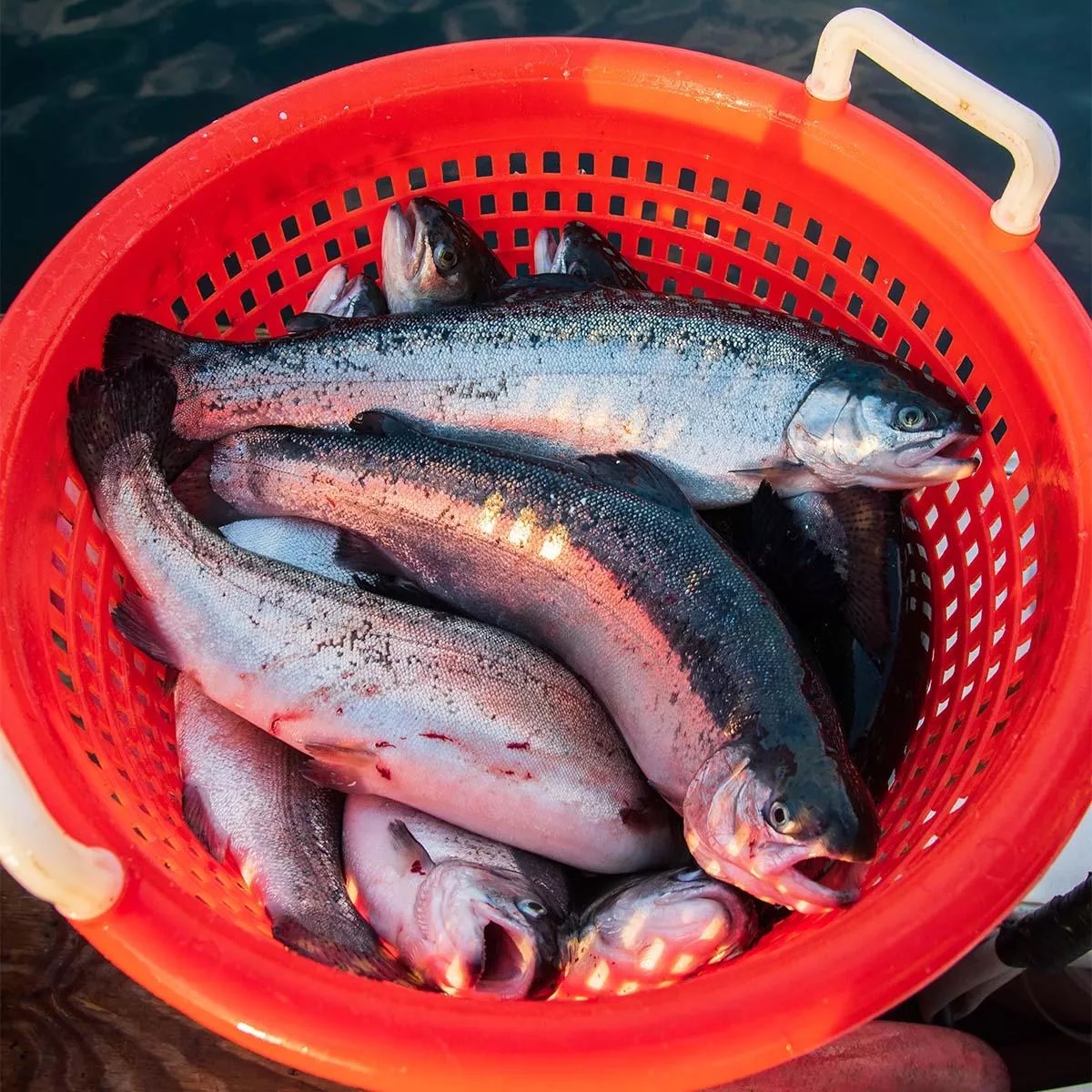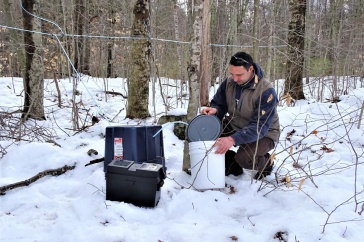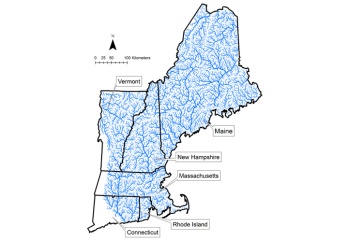New Hampshire’s more than 4,000 farms annually support over 20,000 jobs and provide an economic value of approximately $1.2 billion through a combination of direct product sales, labor and employment, and agritourism. More importantly, they are key contributors to resilient local food systems, each year producing millions of gallons of milk and pounds of fruits and vegetables.
Despite this bounty and New Englanders’ deeply rooted culture of purchasing locally grown products, there are persisting challenges to enabling Granite State farmers to access more markets that support their economic viability, as well as supporting consumers to take advantage of the numerous opportunities and benefits of buying local. Researchers with the New Hampshire Agricultural Experiment Station (NHAES) are seeking ways to strengthen local and regional food systems so that New England farmers can capture greater value from their products, consumers can increase their well-being from local foods, and the overall economy can grow from this increased local and regional supply chains.
One challenge of regional food supply chain models is their ‘hourglass shape,’ with many dispersed food producers on one side, many food consumers on the other, and far fewer food processors, distributors and retailers in the middle. Design credit: Alex Hatch, NHAES
“A key challenge is how food supply chains largely operate—a structure that can be described as ‘hourglass shaped’—with many dispersed food producers on one side, many food consumers on the other, and far fewer food processors, distributors and retailers in the middle,” said Anton Bekkerman, director of the NHAES. “And while food processors and distributors play a key role by converting agricultural products into consumable foods, this supply chain structure can limit direct producer–consumer interactions and reduce economic benefits for both the food producer and consumer. Research can help ask the right questions, better understand the limitations and, ultimately, overcome them.”
Supporting New Hampshire Farmers
Enhancing Market Reach: Collaborative Marketing Models for Small Farms
What resources and information do Granite State farmers need to reach consumers more easily, and how can collaborative marketing models help these farmers pool their resources to reach more customers?
These are questions posed by NHAES researcher Analena Bruce, an assistant professor of agriculture, nutrition and food systems at the UNH College of Life Sciences and Agriculture. Bruce is leading a suite of studies aimed at helping small farms expand their market shares.
“We’re studying ways that farmers in New England–where the average farm is quite small–can leverage partnerships to reach a broader customer base,” said Bruce. “We want to support the development of market channels that work better for both farmers and consumers.”

UNH researchers Analena Bruce and Jess Carson are exploring how collaborative marketing models can help farmers aggregate their products to reach larger customer bases and reduce the time and resources that these same farmers spend on distribution and marketing.
Currently, Bruce is co-leading a project to advance the establishment of collaborative marketing models that help farmers aggregate their products to reach larger customer bases and reduce the time and resources that these same farmers spend on distribution and marketing. These models are an adaptation of more traditional direct-to-consumer (DTC) marketing methods, such as in-person farmers markets, with the major difference being that the collaborative models focus on aggregating products from multiple farms and selling them directly to customers, often through an online platform. Examples of these collaborative DTC models include online farmers markets, multi-farm community supported agriculture (CSA) programs, farm stores and stands that sell products from multiple farms, and food hubs—facilities that help aggregate, store and distribute locally and regionally produced food products). With this study, Bruce is collaborating with Jess Carson, a research assistant professor from the Carsey School of Public Policy.
“These collaborative marketing models often offer greater variety, convenience, and choice for consumers,” described Bruce, “which is why we’re studying whether they attract consumers who don’t participate in traditional DTC markets.”
Expanding Market Access: Collaborations for Reaching Larger Retail Platforms
Bruce and her team at COLSA have also studied how farmers can reach more consumers by collaborating to meet the needs and requirements of intermediaries and large-chain retailers and groceries. Through the formation of strategic partnerships among small- and mid-sized producers, values-based supply chains (VBSCs) offer one method of reaching broader consumer bases. To get a better sense of how VBSCs can help farmers, the team began by interviewing New England-based producers, intermediaries, large-chain grocery store and key informants, to identify key areas where producers can collaborate to reach large retail markets. They found three areas in which producers can share the burden of risk, physical infrastructure, and informational resources.
“For risk sharing, this might look like collectively bidding on contracts to meet advanced volume commitments often required by larger buyers,” said Bruce. “For physical and informational infrastructure sharing, it’s looking at how farmers can collaborate on cold storage, transportation and warehousing needs, as well as on packaging, software systems, and food safety and regulatory certifications.”
Understanding Consumer Preferences: Insights to Broaden the Appeal of AFNs
But where these partnerships may work for some farms, the direct-to-consumer path provides the advantage of scale appropriate markets and higher prices for farmers. However, where these alternative food networks (AFNs), like farmers markets and CSAs, fall short is in reaching a broader and more diverse audience. Bruce and Carson are also studying why the growth of AFNs has plateaued in the past decade. Through a population-based survey of over 2,100 New England consumers and in-depth interviews, they have identified some key insights that farmers and practitioners can use to expand the reach of these markets.
“We learned that New England consumers value taste, quality and affordability above most else. Messaging that emphasizes those key attributes may be especially attractive to potential customers,” said Carson.
“We're also finding some patterns in the characteristics of people who prioritize certain attributes over others in their food purchasing,” Carson added. “As we dig deeper into these data, we hope to understand opportunities for better matching food producers and potential customers around shared values.”
As Bruce and Carson continue to study consumers who don’t traditionally visit AFNs, they gain greater insight into what New England consumers seek from local producers.

UNH researcher Sherman Bigornia is exploring what barriers exist between consumers and local suppliers and producers of dairy and seafood products. Photo credit: Alex Hatch, NHAES
Connecting New Hampshire Consumers
Bridging the Gap: Addressing Barriers to Local Dairy and Seafood Consumption
Station scientist Sherman Bigornia, an assistant professor of agriculture, nutrition and food systems, is seeking to understand how best to connect Granite Staters to local dairy and seafood producers. He has two goals: Support the health of New Hampshire residents and the health of these two food industries, which provide significant economic output for the state.
“New Hampshire has a rich history in both dairy and seafood production,” said Bigornia, “and that continues today with the state’s dairy farms contributing nearly $140 million to the state’s economy and upwards of $17 million to the labor market. On the seafood side, commercial fishing operations bring in roughly $90 million of revenue each year.”
Bigornia also points to previous research showing that regular consumption of dairy and seafood contributes to reduced risk of lifestyle-related diseases like obesity, cardiovascular disease and type 2 diabetes. Data also suggest that both dairy and seafood help improve cognition and decrease symptoms of depression—both important factors in a state ranked eighth in the nation for the highest elderly population.

Previous studies that helped inspire Sherman Bigornia’s research highlight the many nutritional benefits to regularly consuming dairy and seafood products. Photo credit: Tim Bigornia, NH Sea Grant
“In large cohort studies, greater dairy consumption has been shown to be associated with lower risk of type 2 diabetes, whereas fish has shown protective associations with cardiovascular disease,” said Bigornia, adding that “there are plenty of health-related reasons for consuming more dairy and fish and, especially for the Granite State, there are significant economic implications for purchasing local.”
To support these goals, Bigornia is studying the barriers to and facilitators of seafood and dairy consumption among adult New Hampshire residents through a combination of focus grouping, surveying and other methods. This work will help identify preferences toward local versus imported foods, as well as the reasons—personal preference, access, cost, among others—that Granite Staters choose not to consume more dairy products, including milk, cheese and yogurt, and seafood, such as fresh, frozen and canned finfish and shellfish. Once finished, Bigornia and his research team will distribute their findings with the support of UNH Extension to both local and national producers and distributors of dairy and seafood products.
Read more about this research in the latest edition of the NH Agricultural Experiment Station's INSPIRED Research Report, which examines Food Systems, Nutrition and Community Dynamics in the Granite State.
“Ultimately, we want the primary takeaway to be informative and to help guide nutrition planning, such as that provided through the Supplemental Nutrition Assistance Program Education (SNAP-Ed),” said Bigornia. “Once we can better identify why these barriers exist, we’ll work with our partners in extension and across the state to equip both producers and distributors with messaging and other tools that will allow them to build stronger relationships with Granite State consumers from all socioeconomic backgrounds and geographic locations.”
This material is based on work supported by the NH Agricultural Experiment Station through joint funding from the USDA National Institute of Food and Agriculture (under Hatch award numbers 7005875 and 1020097) and the state of New Hampshire.
-
Written By:
Nicholas Gosling '06 | COLSA/NH Agricultural Experiment Station | nicholas.gosling@unh.edu
























































